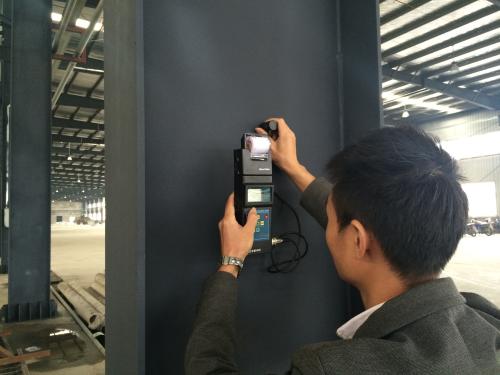Fire-proof and anticorrosion technology for steel structure
- 23 Sep 2019
- steel structure
Fire retardant coatings for steel structure are generally divided into three types: ultra-thin coatings, thin coatings and thick coatings. They are composed of matrix resins, catalysts, carburizing agents and foaming agents. The compatibility of matrix resin with other components not only ensures that the paint has various utilization functions under normal conditions, but also has flame retardancy and good expansion and foaming functions under fire or high temperature conditions.

1. Main Technical Contents
1.1 Coating requirements for ultra-thin and thin-coated fire-retardant coatings
1.1.1 The gravity spray gun is suitable for the primer coating (or main coating) of the thin-coated fire retardant coatings, and the pressure is about 0.4 MPa. Local repair and small area construction can be applied by hand. Surface coating decorative coatings can be brushed, sprayed or rolled.
1.1.2 Two-component coatings with thin coatings shall be prepared on site according to the specifications; one-component coatings with thin coatings shall be fully stirred. Flow and fall should not occur after spraying.
1.1.3 Construction of primer coatings for thin-coated fire-retardant coatings:
A. Surface rust removal and anti-rust treatment of steel should meet the requirements. The steel surface should be cleaned up.
B.Primary coatings are usually sprayed 2-3 times, and the thickness of each layer does not exceed 2.5mm. It should be sprayed again after the previous spray drying.
C. When spraying, the coating should be completely closed and the bonding between the coatings should be firm.
D. Operators should use thickness gauges to measure the coating thickness at any time, and the final thickness should meet the design requirements of the fire resistance limit.
E. When the surface of the coating is required to be smooth, the last coating should be smoothed.
1.1.4 Construction of thin-coated fire-retardant coatings:
A. When the thickness of the base coating meets the design requirements and is basically dry, the surface coating can be applied.
B. Coatings are usually painted 1-2 times. The color should meet the design requirements and cover the bottom layer completely. The color is uniform, the outline is clear and the overlap is smooth.
C. Coating surface with slurry or crack width should not be greater than 0.5 mm.
1.2 Coating Requirements for Thick Coating Fireproof Coatings
1.2.1 Pressure spraying machine should be used to spray thick coatings with air pressure of 0.4-0.6 MPa and gun muzzle diameter of 6-10 mm.
1.2.2 Thick coatings should be added strictly according to the mix proportion and diluent, and the consistency should be appropriate. Coatings used on duty should be prepared in shifts.
1.2.3 Thick coatings should be sprayed separately during construction, and the thickness of each spraying should be 5-10 mm. It must be sprayed again after the previous basic drying or curing, and the protection mode, number of spraying times and thickness of coatings should be determined according to the construction scheme.
1.2.4 The thickness of the coating should be measured by the thickness gauge at any time. The total thickness of 80% or more of the coating should meet the design requirements of the fire resistance limit, and the thickness of the thinnest part should not be less than 85% of the design requirements.
1.2.5 After spraying thick coatings, mastoids should be removed and the surface should be even and smooth.
1.2.6 Re-spraying should be eradicated when one of the following situations occurs in post-coated fire-resistant coatings.
A. Coating is not well dried and solidified, not firmly bonded or powdered, empty and falling off.
B. When the coating on the joint and corner of the steel structure has obvious depression.
C. When the surface of the coating has slurry or crack width greater than 1.0 mm.
1.3 Other requirements
Fire-proof coatings for steel structures should not be mispainted or leaked, and the coatings should be closed without appearance defects such as delamination, hollowing, obvious depression, powder loosening and slurry. Mastoids have been put forward. The appearance of fire-proof coatings for protecting exposed steel structures and open-air steel structures should be smooth, and the color decoration should meet the design requirements.
2. Technical Indicators
2.1 The performance, thickness and quality requirements of fire-retardant materials for steel structures shall meet the General Technical Conditions for Fire-retardant Coatings for Steel Structures (GBl4907-2002) and the Technical Regulations for the Application of Fire-retardant Coatings for Steel Structures (CECS24:1990) Regulations and design requirements.
2.2 Manufacturers of fire-retardant coatings for steel structures must have production licenses issued by fire-retardant supervision departments. Fire-retardant coatings shall pass the national inspection institutions. The product must have the fire resistance limit test report and the physical and chemical performance test report of the national testing agency, and should be accompanied by the paint variety, name, technical performance, manufacturing batch, storage period and use instructions.
2.3 The bond strength and compressive strength of fire retardant coatings should be re-examined before construction.

3. Scope of application
Ultra-thin fire retardant coatings have strong adhesion, fast drying, color matching, decorative effect, no external protective layer, 3-5mm thickness, 2-2.5 hours fire-resistant time limit, suitable for industrial and civil buildings, columns and other steel structures; thin-coated fire retardant coatings have strong adhesion, color matching, generally do not need external protective layer, 2-7mm thickness, 1.5 hours fire-resistant time limit,suitable for industrial and civil building floor and roof steel structure; thick coated fire retardant coating spraying construction, low density, low physical strength and adhesion, need to decorate the surface of the partition, thickness 8-50mm, fire-resistant time limit 1.5-3 hours, suitable for civil building steel structure columns and beams with decorative surface.